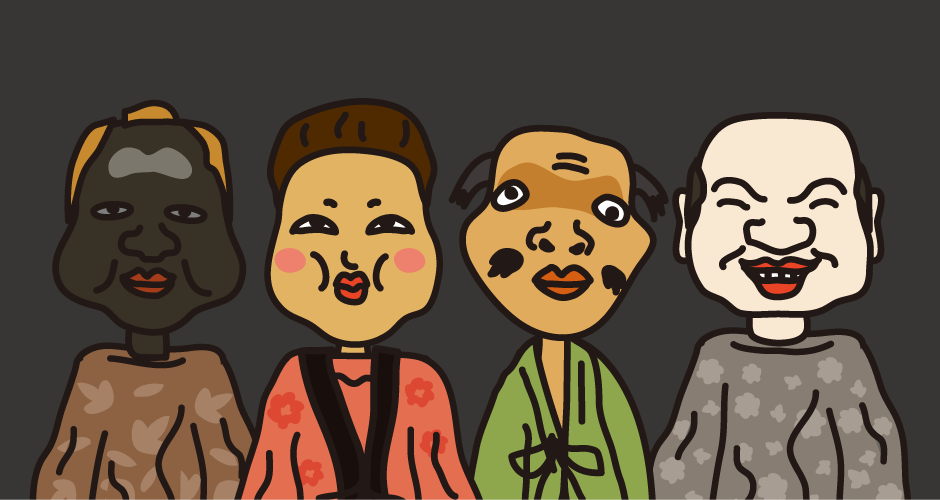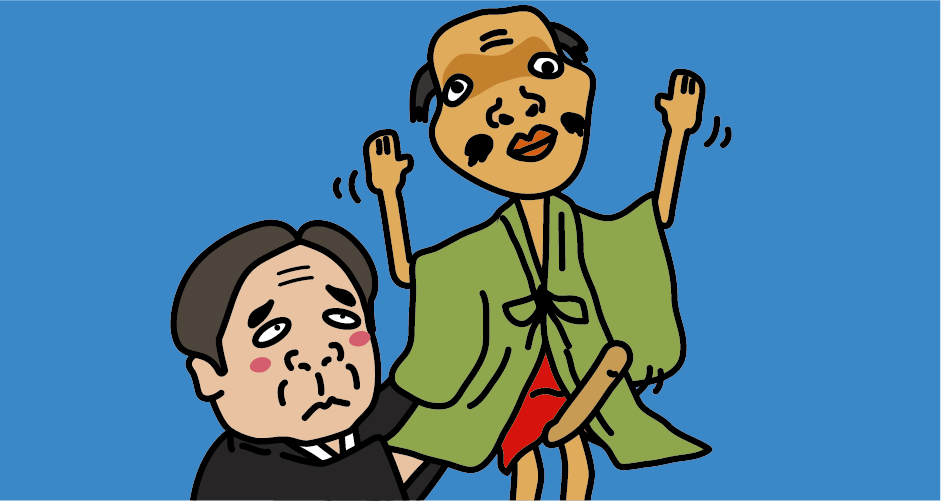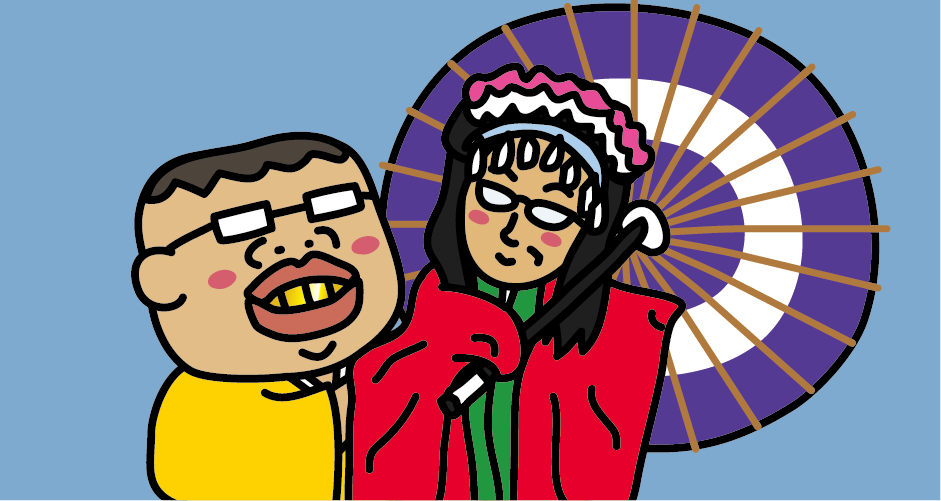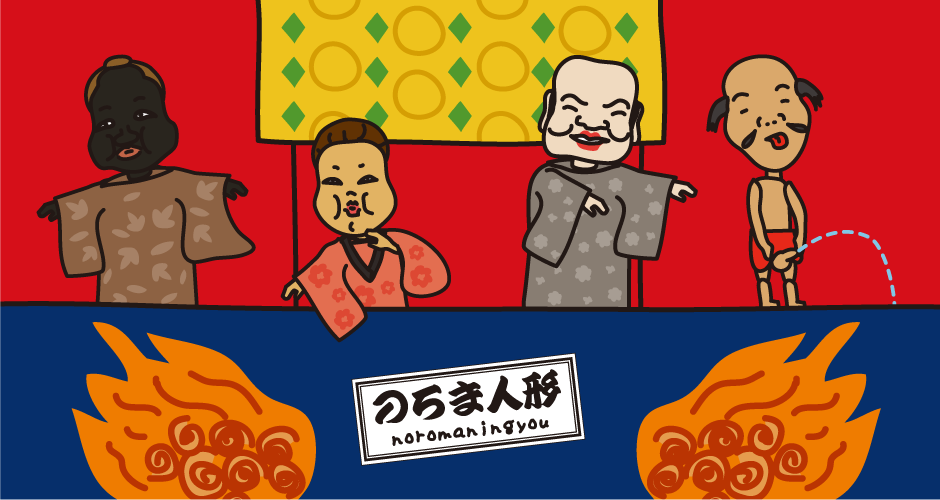Noroma Ningyo, the puppets of simpleton, is a humorous puppet performed in Sado dialect. The stock scene is the leading character always get naked and pissed at there. It is funny no matter how many times you watch it.
In Sado Island of Niigata prefecture, puppet-shows were actively performed since the middle of Edo period (18th century). It was also the time when Sado Island was flourished for Sado Gold Mine. There are three puppet-shows called “Sekkyo Ningyo”, “Noroma Ningyo” and “Bunya Ningyo ” and also they are all designated as important intangible folk-cultural properties. Among them, Noroma Ningyo is a light and funny comedy play using Sado’s old dialect, which was performed between the program of Sekkyo Ningyo. The stories are simple, humorous and a little bit erotic.

The characters are four puppets. From left side, a good-natured man “Shimo no Choja (millionaire)”, a woman wantonly fond of men “Ohana”, an honest but foolish “Kinosuke” and a grabby and mean “Busshi (A Buddha statue maker)”. There are plays such as “Ikijizou (a living Jizo stone statue)”, “Gorinbotoke (A big five Buddha)”, “Soba farm”, “Ohana’s marriage” and “Visiting parent’s house”, however in any endings, Kinosuke, who is the leading character get completely naked and urinated. Some audience even look forward to see that scene as it gets close.
The representative performance is ”Ikijizou”. When Shimo no Choja leaves for a pilgrimage in Shikoku, his wife Hana asked him to buy ikijizou as her souvenir. On the way to Shikoku, Shimo no Choja visits Busshi in Kyoto and orders ikijizou for 25 ryou. A cunning Busshi arranges Kinosuke, who lives next door, to be Ikijizou, and then passed Kinosuke as Ikijizou to Simo no Chojya who came back from Shikoku Pilgrimage. On the way back, Shimo no Choja begins to have a discussion with Jizou, but Shimo no Choja becomes suspicious of Ikijizou’s answers and chased him around. At the ending, Kinosuke is completely naked and urinated there.

It is said that Sado Island’s Sekkyo Ningyo and Noroma Ningyo started in the middle of Edo period (18th century). A nobility of Kyoto gave instruction in puppet-shows and people of Sado Island bought a complete set of puppet and brought them back home.
“Sekkyo” of Sekkyo Ningyo means the priest expostulate the meaning of Buddhist scripture. And with a melody, this is called “Sekkyo bushi(Sekkyo melody)”. Sekkyo Ningyo is the puppet-shows in which a performer plays a shamisen, and tells buddhist-stories with inflection about encouraging good people and good deeds and punishing bad people and bad deeds. This is old form of Ningyo Joruri (puppet play).
Since Sado Island is an isolated island, it seems Sekkyo Ningyo did not influenced from other puppet-shows and never mixed with arrangements or fashion in it. It is said that it still remains in the form which is close to the time when it was transmitted at first time. As you can find the description of Noroma Ningyo in Ryunosuke Akutagawa’s essay, “Noroma Ningyo”, it remained in Tokyo from the end of Edo period till Taisho era as a party performance of wealthy people, but now it disappeared at all, and Sado Island is the only place perform this show.

Bunya Ningyo is a Ningyo Joruri (puppet play) that Sekkyo Ningyo of Sado Island and “Bunya bushi” are mixed in early Meiji era. “Bunya bushi” was one school of popular old Joruri in Osaka in the latter half of the 17th century. Its melody has characteristic mournful sound and it is also called as crying bushi. Since Bunya melody of Sado Island was handed down among blind people, it is said that it left in the form that close to founder’s talk.
Puppet dolls for Sekkyo Ningyo, Noroma Ningyo and Bunya Ningyo are exhibited at Niibo Museum of History and Folklore.
Access to Niibo Museum of History and Folklore
From Tokyo
It takes about 2 hours from JR Tokyo Station to JR Niigata Station by Joetsu Shinkansen. It takes about 15 minutes by local bus from JR Niigata Station to Niigata Port.
From Osaka
It takes about 1 hour from Itami Airport to Niigata Airport. It takes about 25 minutes by shuttle bus from Niigata Airport to Sado Kisen Niigata Port Terminal.
From Sado Kisen Niigata Port Terminal to Sado Kisen Ryotsu Port Terminal, it takes about 1 hour by jetfoil and about 2 hours and 30 minutes by car ferry.
It takes about 20 minutes from Ryotsu Port Sado Kisen Bus Stop to Niiho Yubinkyoku-mae Bus Stop by local bus (south line). Get off at Niiho Yubinkyoku-mae Bus Stop and walk for about 5 minutes.
